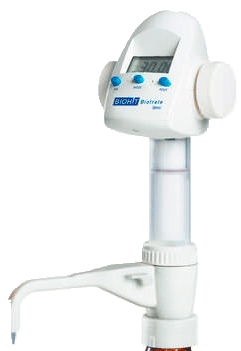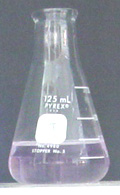Upon completion of this lab go log onto OWL. A Lab Owl section should now appear in your courses and your third assignment, Lab Owl: Exp 3 should appear in this section. You have one until your next scheduled laboratory to complete this assignment. Two more assignment will appear as the semester progresses. Remember, these Lab Owls are worth 25% of your laboratory grade.
Introduction
In the previous experiment you were introduced to molarity when you made a sodium hydroxide solution of known concentration. To test the accuracy of the solution that you made, you titrated a sample with hydrochloric acid. In this experiment you will be testing the effectiveness of commercial antacids by determining the amount of acid that they neutralize by titration. There are no new stoichiometry concepts in this lab rather it combines the concepts that you have met in the last two experiments, namely:
- Solids .... # moles = mass in grams/Molar Mass
- Solutions ... # moles = Molarity x V(L)
How Antacids Work
Heart burn and acid indigestion are primarily due to excess acid in the stomach. There are many preparations sold over the counter to relieve these conditions, many of which act by neutralizing the excess acid in the stomach, and some may be more effective than others! In most of these products, other ingredients are added, flavoring agents and substances to soothe the walls and lining of the stomach, binders to make the tablet hold together and so forth. The active ingredients, however, are there to neutralize the excess acid in the stomach.
Among the most common active ingredients are: Mg(OH)2 (the active ingredient in milk of magnesia), NaHCO3 (sodium bicarbonate) and CaCO3 (calcium carbonate) and in some Al(OH)3 (aluminum hydroxide). You are going to evaluate some of the commercially available antacids by determining the amount of HCl (stomach acid!) that one tablet will neutralize.
The reaction between the metal hydroxides and the stomach acid is an acid base reaction very similar to that in the previous experiment:
Mg(OH)2(s) + 2 HCl(aq) = MgCl2(aq) + 2 H2O(l)
Metal carbonates, which are the most common active component in antacids, neutralize the stomach acid by forming a salt, water and a gas.
CaCO3(s) + 2 HCl(aq) = CaCl2(aq) + H2O(l) + CO2(g)
The Tactic
Since different antacids neutralize stomach acid using different but similar reactions our tactic is to add an antacid tablet to a known quantity of hydrochloric acid. When the antacid has reacted completely we will then determine the amount of hydrochloric acid remaining by titrating it with a sodium hydroxide solution whose concentration we know. The reaction is identical to that which you used in the last experiment.
HCl(aq)remaining + NaOH(aq) = NaCl(aq) + H2O(l)
From your knowledge of solutions you can determine the number of moles of HCl that was added.
- You know the volume of HCl that you added, and
you know its molarity.
Some of this acid will then be neutralized by the antacid. - From your titration you can determine the amount
of sodium hydroxide used to neutralize the remaining hydrochloric acid.
#mol = Molarity of the NaOH x V(L)
From the balanced chemical equation, this can be converted to moles of acid remaining. Now it is a case of subtraction to determine the moles of acid neutralized.
In order to do a comparison between the antacids you will need to calculate:
- 1. The number of moles of acid neutralized per gram of tablet.
(The amount of acid neutralized divided by the mass of the tablet)
- 2. The number of grams of acid neutralized by a 10 gram tablet.
 |
To dispense the HCl you will be using a Digitrate Pro Digital Burette. This dispenser can deliver 1-30 mL of liquids with a digital display that records the volume to two decimal places with an accuracy of 0.2% The device, which is depicted on the left while easy to use, should be treated with care as its internal parts are expensive to repair. Your TA will demonstrate how to use this dispenser. |
Experimental Procedure
Evaluation of Commercial Antacids
- Obtain two antacid tablets. Record the brand name.
- Wash thoroughly two 125-mL Erlenmeyer flasks. Rinse thoroughly with distilled water. The flasks may be left wet on the inside, but the outside should be dried.
- Place a 125-mL Erlenmeyer flask on the balance. Tare the balance, add one of your tablets and record its weight. Repeat with the second tablet (use a different flask).
- Add 15mL of ~1M HCl and 10mL of water. Use the designated 'Digitrate Pro Digital Burette' to dispense the HCl. Make sure you record the exact molarity of the acid.
-
Add three to four drops of phenolphthalein indicator to each flask.
- Fill your wash bottle and buret with distilled water. Drain the buret and note whether it runs clean and does not leak. If drops of water adhere to the inner walls, clean the buret with the solution and brush found on the end bench. If the buret leaks, consult with your TA.
- Rinse the buret with two or three 10-mL portions of the sodium hydroxide solution, fill the buret with this solution and record the exact molarity of the sodium hydroxide.
- Remove any air bubbles from the tip of the base buret. Take the initial buret reading to the closest 0.01 or 0.02mL. Record data to TWO decimal places, with no readings coarser than ± 0.02mL.
-
 Titrate
each to the first faint permanent color change.
Titrate
each to the first faint permanent color change. - Record the volume of NaOH required to reach the equivalence point.
- For these two trials, determine:
- The average moles of acid neutralized per gram of tablet.
- The average grams of acid neutralized per gram of tablet.
- The number of grams that would be neutralized by 10g of these tablets.
You should compare this value with that of a colleague who has analyzed a different brand. How does your brand stack up?